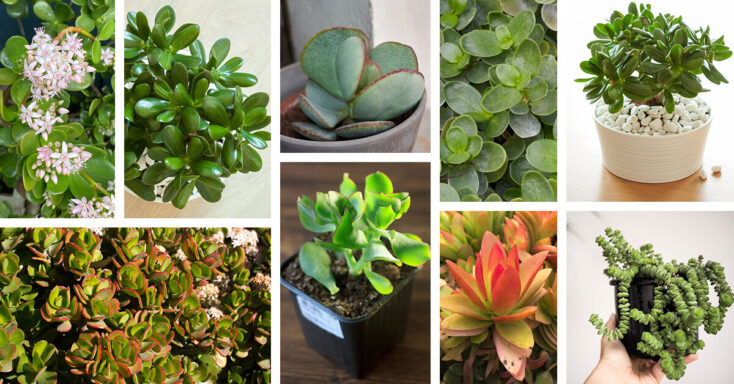Whether you call them money plants, friendship plants, or jade plants, this group of plant species and cultivars has earned its right to be a mainstay in the indoor gardening community. Jade plants have just about everything that you could ask for if you want a plant that will reward you for very little effort.
Jade plants need plenty of sunlight, but other than that, they are not very picky. In fact, they prefer to be watered and fertilized on a very infrequent basis. What also adds to the low-maintenance nature of jade plants is that they don’t need much pruning, either.
All the while, each of the jade plants on our list proves to be a succulent of the highest quality. These 13 plants will impress you with a surprisingly wide range of growth habits and foliage types, all of which make for an incredible set of plants that any indoor gardener would be lucky to own.
Key Takeaways
Each type of jade plant comes with its own set of interesting facts and features, but as you’ll see, there are a few key takeaways that ring true for all jade plants. These commonalities are what help define jade plants as a group and are crucial to your knowledge about the topic. As you read through our list, be sure to keep in mind these five insights that will appear and reappear throughout the article.
- True jade plants belong to the genus Crassula, but each species has a different common name.
- Jade plants have lovely foliage that is usually thick and fleshy.
- Jade plants come from South Africa and love growing conditions that are hot and dry.
- Jade plants are not only beautiful but are very easy to care for as well.
- There are many different jade plant cultivars, many of which have very interesting growth habits.
13 Fortune-Filled Types of Jade Plants that Might Just Bring You Good Luck
1. Jade Plant (Crassula ovata)
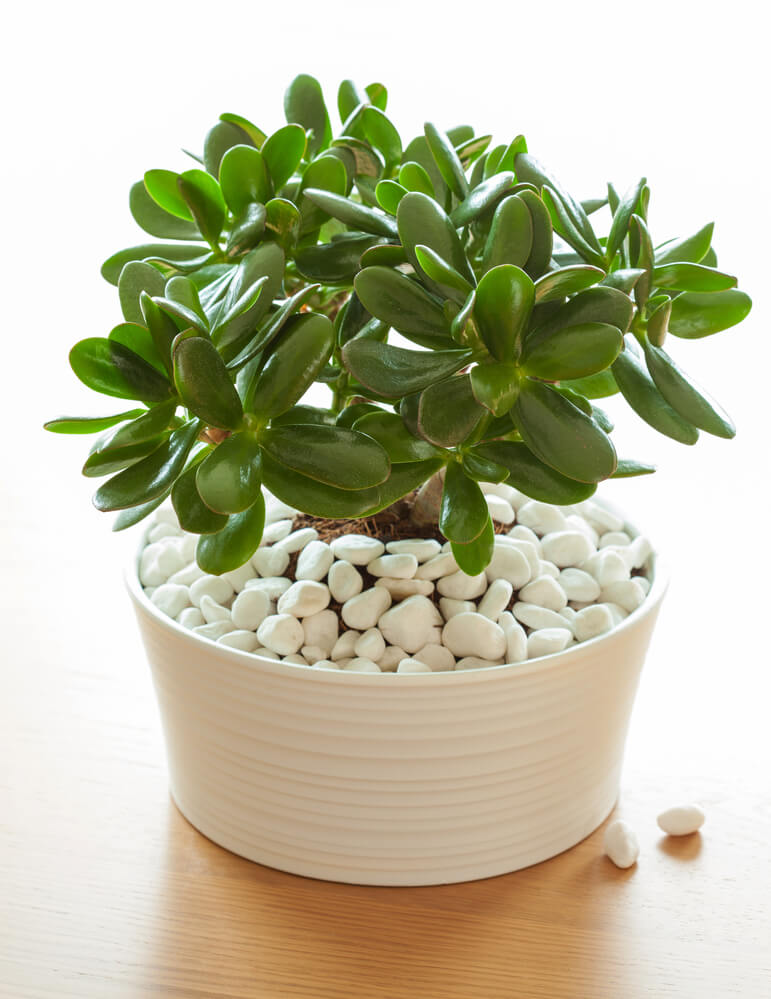
There is no better way to start our list than with the plant that is the original jade plant species, otherwise known as Crassula ovata. To the surprise of some, this plant has its origins in South Africa, a native range in which it enjoys hotter climates with temperature ranges similar to USDA hardiness zones 10 to 12. But despite coming from a distant area of the world, jade plants have become incredibly popular throughout many countries, including much of the United States. What has allowed jade plants to earn that popularity is a mixture of simple beauty and the fact that they are easy to care for in most cases.
This jade variety is far from the only species that claims the jade plant name, but it is the starting point for many of the jade plant cultivars that you’ll see later on this list. Likewise, you’ll learn that there are other species within the Crassula genus that belong to the jade plant family. However, this species should be the entry point for anyone who is just getting started with jade plants. Crassula ovata carries all the quintessential jade plant characteristics and is an ideal option for beginner indoor gardeners. Now let’s move on to learn about some of the outstanding ornamental features that the cultivation of this species has led to.
2. Botany Bay (Crassula ovata ‘Botany Bay’)
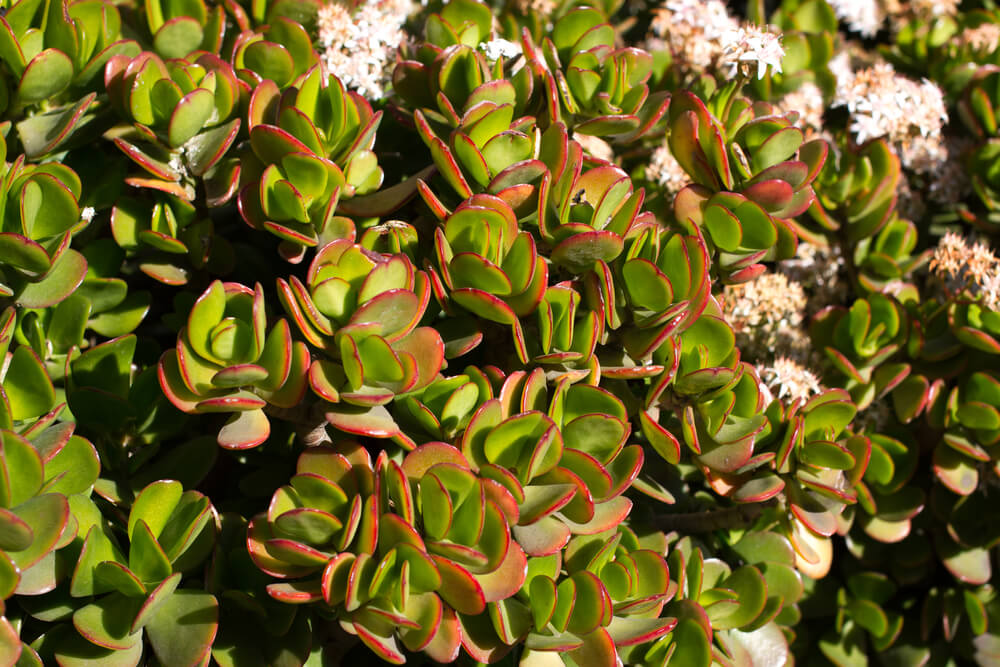
The second cultivar we’ll introduce on this list is one of the many to follow that comes from the Crassula ovata species. This variety bears the name botany bay and is a relatively recent addition to the nursery trade, having come into existence within the last 20 years. What makes this cultivated variety stand out from other jade plants is the unique coloration of its leaves.
Botany bay jade plant leaves are large and thick and usually have a rich green color that can fade to a more yellow-green in some cases. But that’s not what makes this jade plant unique. Instead, the defining feature is a small hint of dark red that traces the margin of each leaf. This colorful margin may not always be present, but that does not prevent the botany bay jade plant from looking beautiful nonetheless. Interestingly, that distinctive red tint on the margin is often more prominent in certain settings. Mainly, extreme heat and color are more likely to cause this plant to hold bolder colors.
3. Gandalf Jade (Crassula ovata ‘Gandalf’)
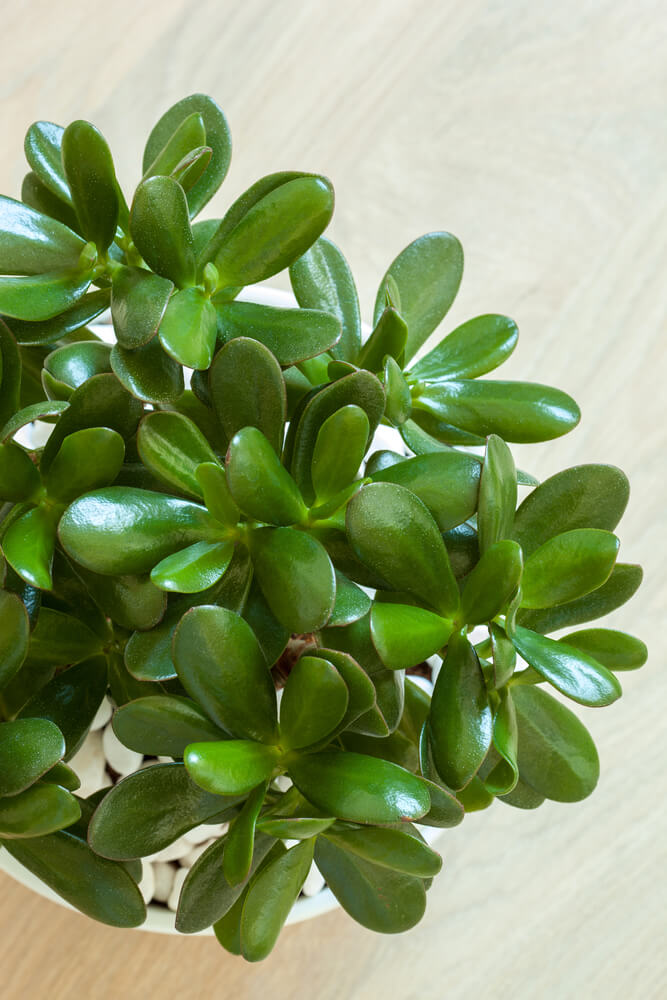
This entry is the first of three plants that have an appearance that is not only fun but borders on being a bit fantastical. That otherworldly look is the primary reason why these three plants each have a name inspired by an incredibly well-known book and movie series—J.R.R. Tolkien’s Lord of the Rings. The first plant in this series of three goes by the name Gandalf jade.
You might expect that since the three jade plants we just mentioned all have a name based on the same source, they would also look incredibly similar as well. However, that is not entirely the case, as the Gandalf jade is the one that stands out as being a bit different. While the next two plants have narrow tubular foliage, the leaves of the Gandalf jade plant prove to be much thicker while also maintaining a somewhat tubular shape. But that difference is by no means a negative. Instead, the variation in leaf style is what makes the Gandalf jade plant stand out among an already noteworthy group of plants.
4. Gollum Jade (Crassula ovata ‘Gollum’)
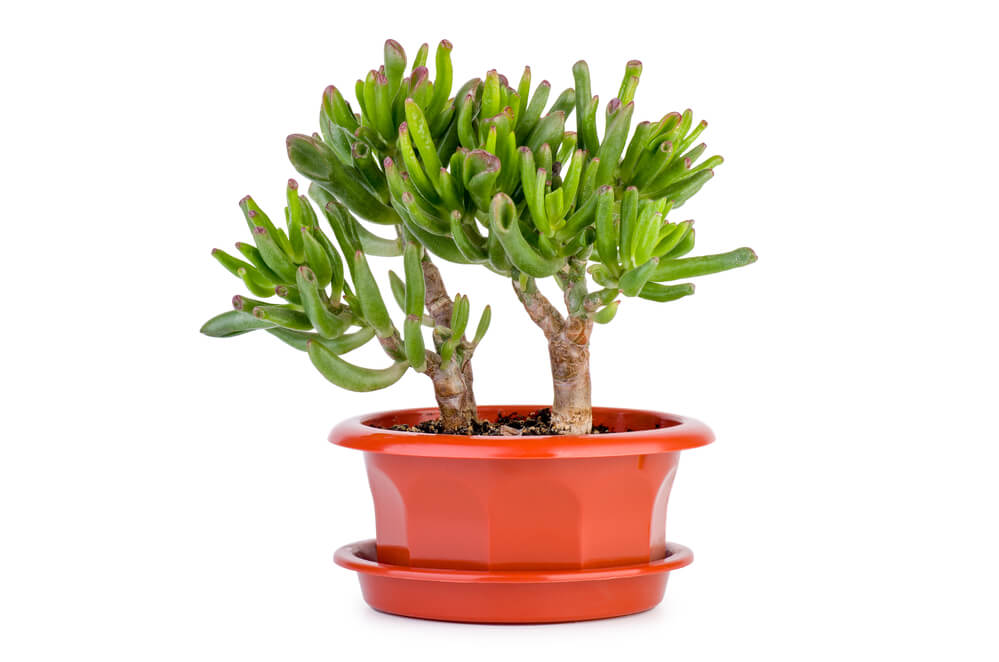
This next jade plant in what we could call the Lord of the Rings series has a look that is a bit more sinister, but that will be no surprise to anyone familiar with the trilogy and one of its disturbing characters. The Gollum jade plant has foliage that is long, rounded, and somewhat spindly, much like a set of creepy fingers that might belong to its namesake character.
However, while the appearance of a Gollum jade plant implies a somewhat darker tone, this plant is as much of a sun lover as any other jade plant that you’ll see on this list. As such, if you choose to plant the Gollum jade plant, make sure to place it in an area that remains warm and full of bright sunlight for most of the day.
5. Hobbit Jade (Crassula ovata ‘Hobbit’)
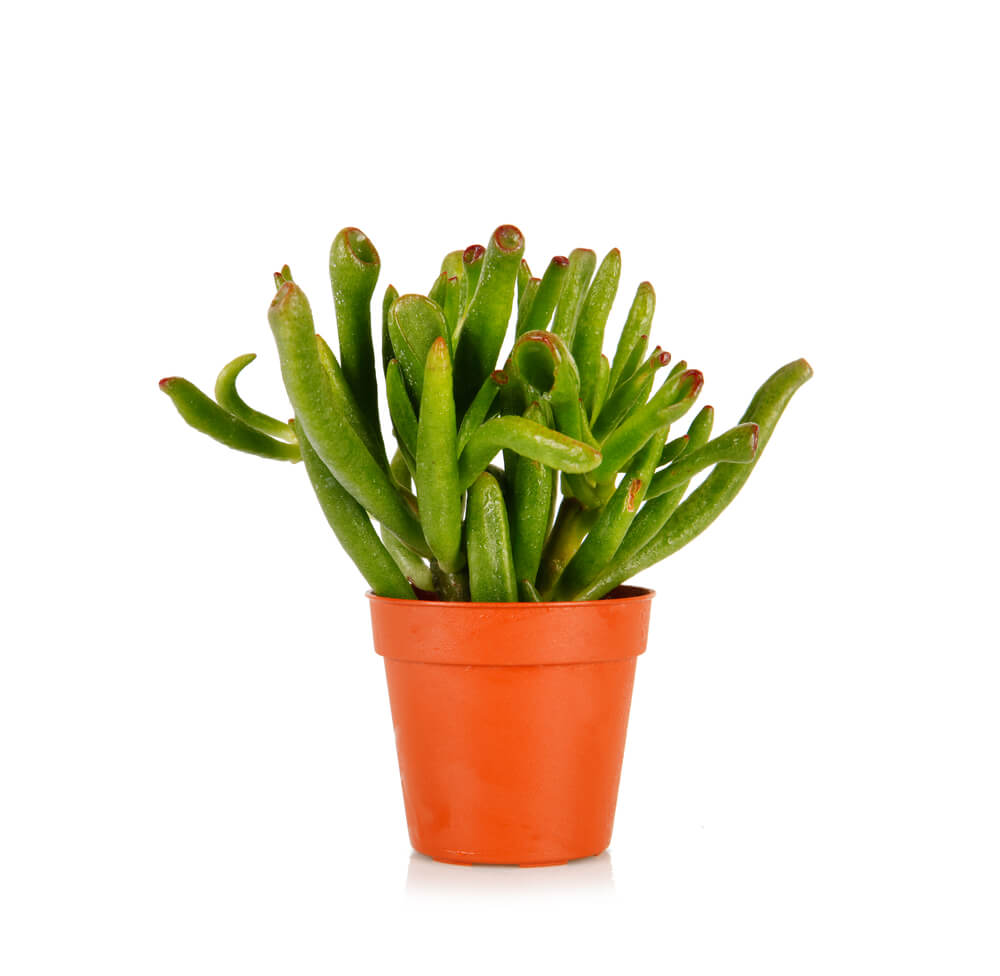
Here’s the last of the three Lord of the Rings-inspired jade plants on our list. But make no mistake, the hobbit jade is just as interesting and worth your consideration as any other jade plant that we’ll present. Like the previous plant on this list, the Hobbit plant has foliage that is linear, tubular, and a tad on the crooked side. At the end of each piece of foliage, you’ll see a saucer-like opening, which, at times, can have a reddish tint that adds to this plant’s depth of beauty.
Like a true Hobbit, the Hobbit jade plant begins with a remarkably small stature. For much of its early life, this plant will appear as a set of small, upward-heading green shoots that fill whatever container you choose to plant it in. As this plant develops, so does its form. Rather than remaining as a series of shoots, the Hobbit jade plant develops some woody stems and branches, which allow it to adopt a form that more closely resembles that of a miniature tree.
6. Pink Beauty Jade (Crassula ovata ‘Pink Beauty’)
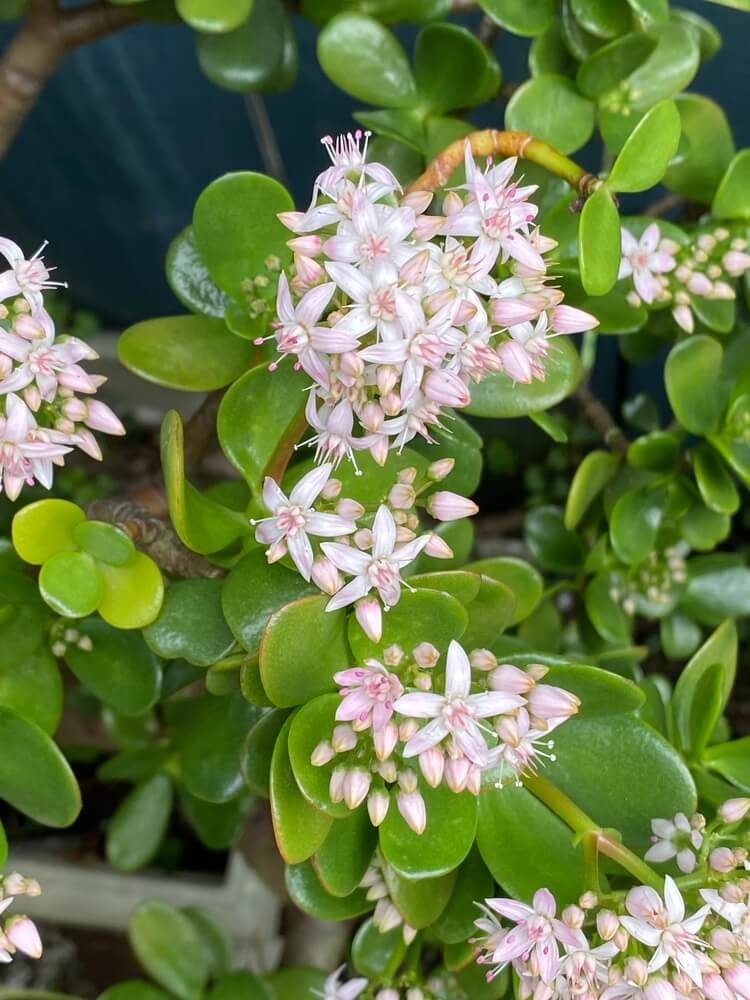
Although our next list entry no longer holds names that come from a film series, it remains a cultivated variety of the same species, Crassula ovata. But while this plant is a member of that same original jade plant species, it is one that is incredibly easy to distinguish from its many relatives. Take one look at the variety we call the pink beauty jade, and you’ll have no reason to wonder why that is the case.
For many jade plants, the primary source of their ornamental value is their foliage. Make no mistake, the leaves of the pink beauty jade plant are lovely in their own right, but it is the floral characteristics of this plant that make it worth your time to choose it over the many other jade plant options. The pink beauty jade plant grows with a rounded, almost shrub-like form, over which bloom clusters of star-shaped pinkish-white flowers.
7. Skinny Fingers Jade (Crassula ovata ‘Skinny Fingers’)
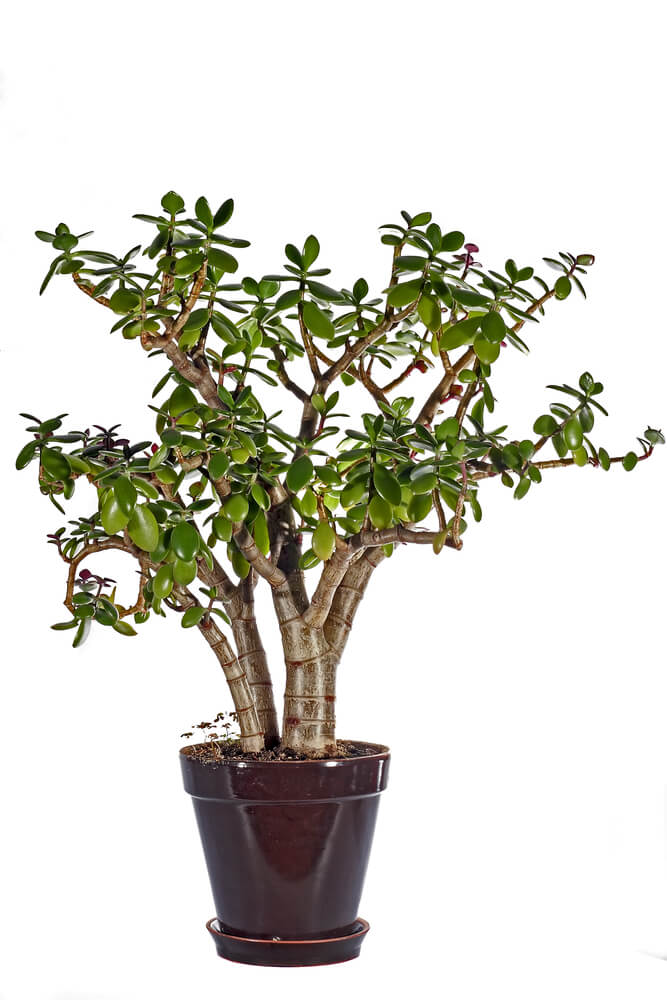
The skinny fingers jade plant is the last jade plant on our list that is a cultivar of the Crassula ovata species. However, you should not let that cause you to believe that we’ve exhausted our options from this lovely species. The reality is that there are plenty more cultivars of this plant that you should explore on your own. But with that said, the striking beauty of the skinny fingers jade plant may put an end to your search for the perfect plant entirely.
This cultivar tends to have a similar appearance and care routine as some of the jade plants that we have already mentioned. Like the Gollum and Hobbit jade plants, the skinny fingers jade plant has long, almost spindly leaves. Like the pink beauty, this plant also holds star-shaped flowers in winter. Still, despite holding those similarities, we’re sure you’ll find that the skinny fingers jade plant maintains an individual character that you are sure to love.
8. Silver Dollar Jade (Crassula arborescens)

We have not mentioned it much so far, but sometimes the jade plant also goes by the name money plant. But what’s even more interesting is that this jade species has an even more specific name that’s related to currency and perfectly describes its form. The silver dollar jade plant has foliage that is very round and has a silvery color that makes many people think of silver dollar coins. Along with that, each leaf also provides contrast in the form of a magenta streak that runs along the rounded edge of the leaf.
The silver dollar jade plant is the first of several plants on our list that are part of the Crassula arborescens species, and if you want to keep yours looking like a million bucks, you’ll need to know how to give it the right treatment. One of the most important factors when caring for a silver dollar jade plant, or most of the other jade plants for that matter, is soil moisture. Or, rather, a lack of soil moisture. Silver dollar jade plants love to live in a growing medium that has fantastic drainage. It is also important to avoid overwatering this plant as that can easily lead to root rot.
9. Blue Bird Jade (Crassula arborescens ‘Blue Bird’)
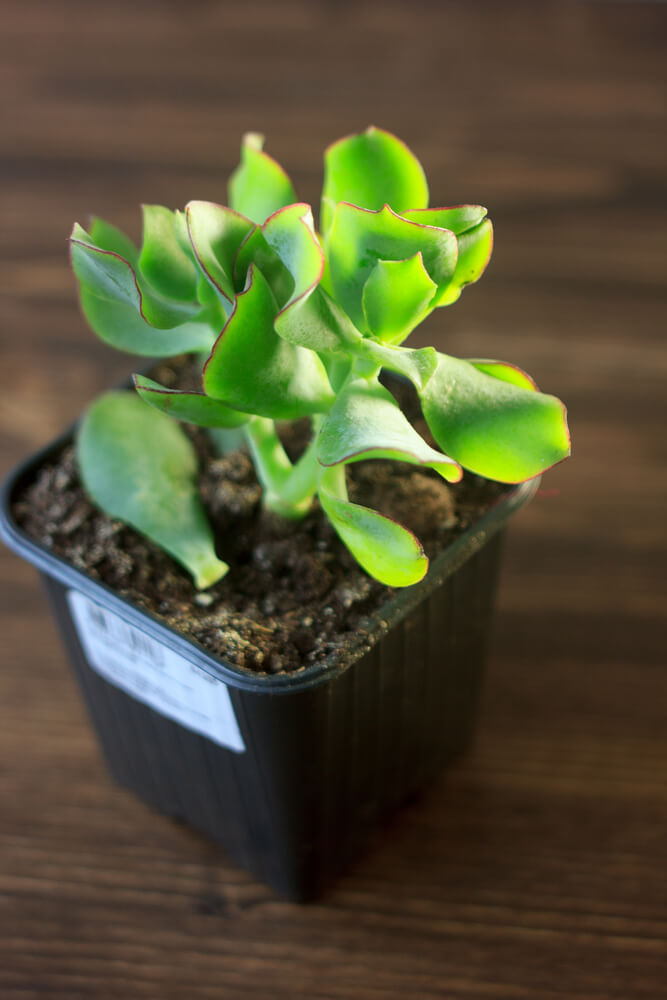
There is some dispute within the plant community about which species the blue bird jade plant belongs to. Some claim it is a member of the Crassula ovata or is a cross between multiple species. But what’s most likely is that this remarkable jade plant is a member of the Crassula arborescens species. What people do not argue about is the incredible beauty of this plant. The blue bird jade plant has bluish leaves, which can sometimes have a wavy form. This plant also blooms with white flowers that provide a nice contrast to those blue leaves.
When growing outdoors, the blue bird jade plant can grow to be a relatively large plant at about two to three feet tall. However, most people in the United States and Europe have been growing this plant indoors for about the last 80 years due to its inability to survive temperatures below 20 degrees Fahrenheit. Still, the relatively large size of this jade plant makes it a good option for those who love o practice the gardening art known as bonsai.
10. Jade Necklace (Crassula marnieriana ‘Jade Necklace’)
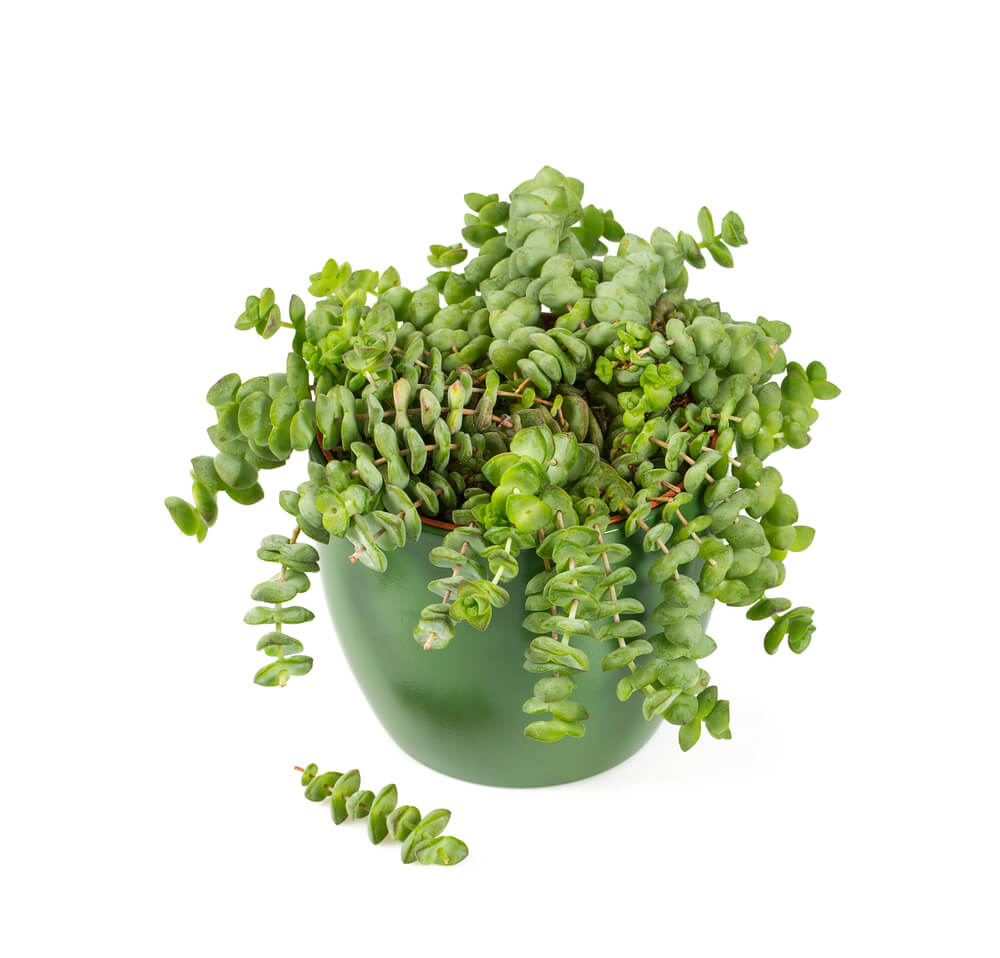
Those who are familiar with one or a few jade plants can make the incorrect assumption that most plants within the jade family have a similar, if not identical, form. Unfortunately for those uncurious people, jade plants continue to prove that they can come in many different and equally captivating forms. One of the best examples of that is this entry on our jade plant list, the jade necklace.
Like a real jade necklace, this plant will give any indoor living space a new sense of elegance. It grows with long segments that are slightly erect but often have an almost sprawling habit that spills out the sides of the container that holds it. Jade necklace plants also have a vibrant light green color and subtle hints of red that make it all the more dynamic. Another reason why this plant is such a great indoor plant option is that it prefers the dry air that is more common inside than outside.
11. Jade Tower (Crassula marnieriana ‘Jade Tower’)
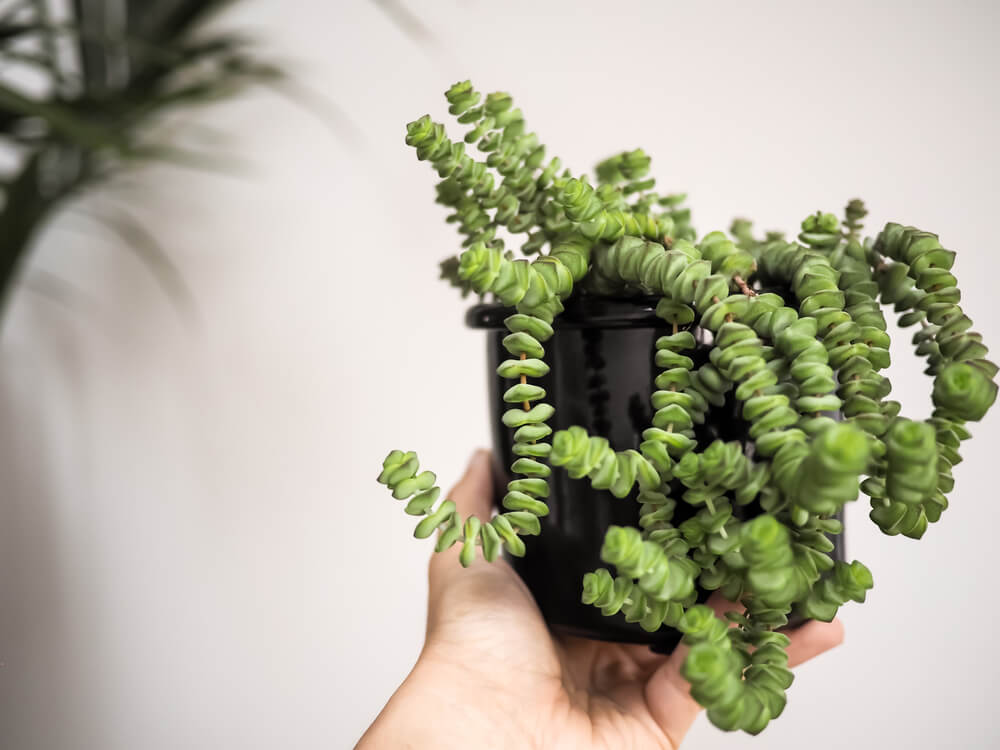
Since it comes from the same species, the jade tower shares a lot of similarities with the jade necklace. However, there are some differences that are worth pointing out. For instance, while the jade necklace and jade tower both grow with long linear stems, the leaves of the jade tower are often a bit thicker and larger overall. Along with that difference in foliage, the jade tower also tends to be more structurally sound in that it grows more upright rather than trailing along the ground.
At times, this plant can have some issues with mealy bugs and fungal diseases. But the former of those issues is usually easy to treat. On the other hand, when it comes to fungal issues and root rot, prevention is the best method. The ideal way to avoid these issues for your jade tower plant is to prevent its environment from becoming too moist, whether that means excessive humidity in the air or too much water in the soil.
12. Fairy Crassula (Crassula multicava)
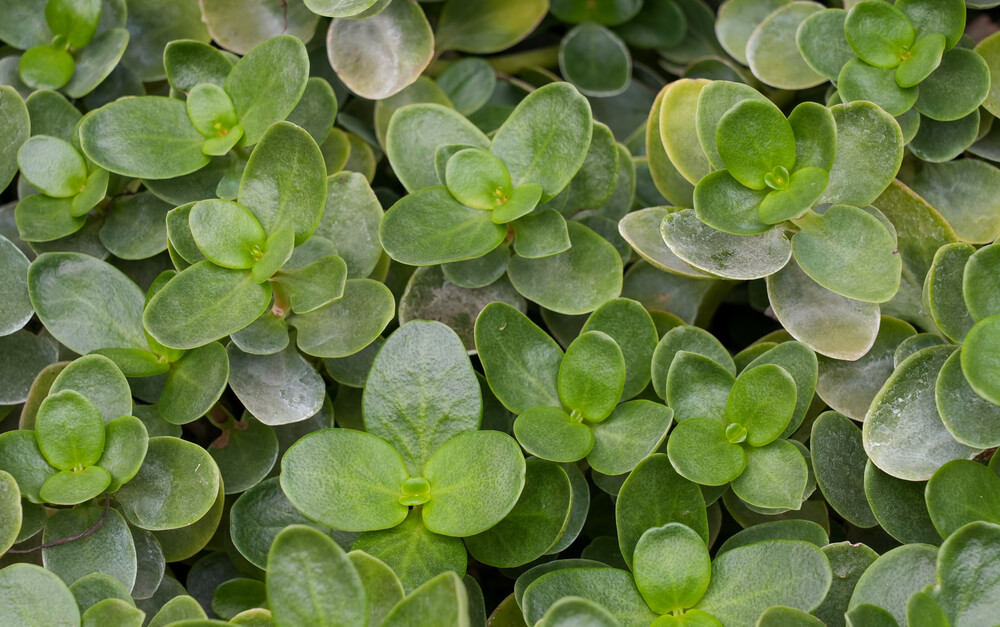
As we near the end of our list, we continue to see that jade plants can be one of several species but that each of those species has distinct traits that make it stand out visually. Such is true of the plant known as fairy crassula or Crassula multicava. The leaves of the fairy crassula plant are small and round and are often thinner than the fleshy foliage that you would expect to find on a jade plant.
Those leaves can also have some incredible color variation, even within the same leaf. At times, both shades of green and light purple are visible. Along with that, the fairy crassula develops long stalks that stand above the foliage and hold the light pink flowers that bloom each year. Those tiny flowers often have four pointed petals that, in the aggregate, make for a light and fluffy texture over the plant.
13. Campfire Crassula (Crassula capitella ‘Campfire’)
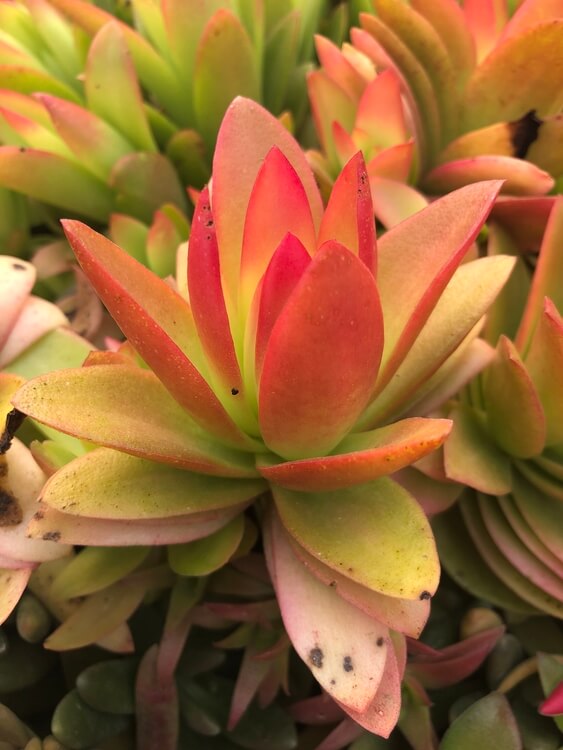
Regardless of what plant category we discuss, there will always be gardeners who value color above all other plant features. Fortunately for those people, the jade plant family has a perfect offering for you. The campfire crassula is one of the most striking plants you can find, thanks to its vibrant colors. At times, this plant’s leaves may not show green at all. Instead, they have intense shades of red and yellow.
This fiery plant is well worth your consideration any time you want a pop of color in your home. Additionally, you’ll find that the campfire crassula is easy to care for, like other jades, as it prefers to survive on a low amount of water and requires minimal pruning. The campfire crassula also stands out for being slightly more shade tolerant than other jade plants, as it can survive in partial shade, while related plants need full sunlight in nearly every case.
Frequently Asked Questions About Types of Jade Plants
Are there Male and Female Jade Plants?
Jade plants belong to a group of plants known as dioecious plants. Dioecious plants are defined by the way in which they reproduce. Rather than holding both male and female reproductive organs on the same plant, each jade plant will be either entirely male or entirely female. As such, jade plants are not self-pollinating species, which means that you’ll need more than one, at least a male and a female, if you want your jade plants to have the chance to reproduce via pollination. At first, this fact about jade plant reproduction seems at odds with most of the plant world, but it’s not that hard to believe when you remember that most animal species follow the same reproductive pattern.
What is the Most Expensive Jade Plant?
There is no way to know which individual jade plant is the most expensive in history, but there are plenty of rumors about the topic. Some of those rumors claim that the most expensive jade plants in the world can sell for several thousand dollars. However, such prices for jade plants are exceptionally rare. In the most common of situations, jade plants are not expensive at all. That affordability, along with unique beauty and a simple care routine, are all some of the many reasons why jade plants are so popular.
How Do I Identify a Jade Plant?
After you become acquainted with jade plants, it will become incredibly easy for you to identify them. Of course, each jade plant species and its cultivars will have unique traits that make them stand out from the other jade plants that are available to you. But with that said, most jade plants have some similar characteristics that you’ll come to know. For example, jade plants are a type of plant known as a succulent. Succulent plants have thick fleshy leaves that are different from those of other plant types. Jade plant leaves are often round as well and tend to have a glossy texture.
Do Jade Plants Have Babies?
Jade plants certainly have the ability to reproduce, but they often do not have the chance to do so for several factors. However, that does not imply that you cannot make more jade plants from the ones you have. Admittedly, your jade plant will probably not reproduce via pollination, but you can propagate it via cuttings. Small cuttings from established jade plants are able to take root in soil when conditions are right, and, at times, it’s fun to think of these cuttings as smaller baby versions of your original jade plant.
Are All Jade Plants Lucky?
Like other plant types, jade plants have come to earn some symbolic meaning over the years. In a general sense, many people consider jade plants to be lucky. Others take this symbolic meaning a bit further by implying that this so-called money plant may bring you wealth. Additionally, some people are even more precise about this topic as they believe that where you choose to place your jade plant factors into the amount of luck, it will bring. Believe what you wish about jade plants and their luck, but it’s not fair to say that one of these plants is definitively luckier than another.
Jade plants are both commonplace among the indoor gardening community and quite intriguing at the same time. In fact, the jade plant family offers a lot of information for you to learn if you are one of the many people who are fascinated with this plant group. Many who take an interest in jade plants have already come across the answers to the questions below, but for those who are new to the game, the next few sections will help a lot to round out your knowledge of jade plants and their many interesting facts. Read on to become a few steps closer to earning the right to call yourself a jade plant expert.
13 Luscious Types of Jade Plants with Leaves that Are Thick and Fleshy
Jade plants go by many different names, and you now know that each of those jade plant varieties has something to offer that most of the others don’t. Whether that be a divergent growth habit or a different type of leaf shape or color, jade plants have a surprising amount of variety. That variety pairs so well with this plant group’s ease of maintenance. All in all that means that choosing one of the jade plants on this list will give your home a lush new piece of interior décor that essentially cares for itself.


